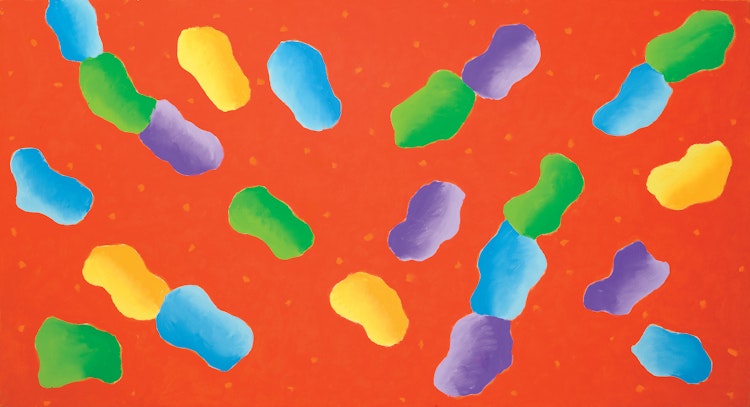Orange II by Gershon Iskowitz

Gershon Iskowitz
Orange II
oil on canvas
signed, titled and dated 1983 with a Gershon Iskowitz Foundation stamp (Inventory No. B182) on the reverse
38 x 70 ins ( 96.5 x 177.8 cms )
Auction Estimate: $18,000.00 - $22,000.00
Price Realized $12,000.00
Sale date: December 1st 2022
Collection of the Artist
Gallery Moos, Toronto
Gershon Iskowitz Foundation
“Gershon Iskowitz & Michael Walker”, Newzones Gallery of Contemporary Art, Calgary, 8 April‒6 May 2006
“Gershon Iskowitz: Paintings from the 1980s”, Miriam Shiell Fine Art, Toronto, 14 October‒4 November 2006
Thielsen Gallery, London, 2007
Adele Freedman, “Gershon Iskowitz: Painter of Light”, Toronto/ Vancouver, 1982, page 153
“Gershon Iskowitz: Paintings from the 1980s”, Miriam Shiell Fine Art, Toronto, 2006
A number of significant canvases from the late 1970s and early 1980s feature the use of high-key orange. Iskowitz created “Orange Painting No. 1” in 1977, and followed up this chromatic experiment with” Orange II” a few years later. “Orange II” features ovoid forms which oscillate between solids and openings, creating an ambiguous play of visual depth. Set off by contrasting hues, each form is energized by optical vibrations at their boundaries. The forms are arranged in loose diagonals, adding dynamism to the composition. The large scale and wide, horizontal format of the picture envelope the viewer in immersive colour. In 1982, the Art Gallery of Ontario held a retrospective of Iskowitz’s work, a noteworthy cultural achievement at the time for a living artist. Only sixteen years had passed since Iskowitz’s first modest gallery exhibition in Canada.
The joyous and life-affirming paintings of Gershon Iskowitz are particularly powerful considering the artist’s traumatic early experiences as a Holocaust survivor. Writer Adele Freedman observed: “Painting is the disciplined human activity with which he searches to unite his present and his past, to bridge the rupture caused by the war. That urge to unify his experience stands behind everything he does, providing an emotional depth to his work which goes far beyond making images of the land from a helicopter window.”
Proceeds from this sale will benefit the charitable not-for-profit Gershon Iskowitz Foundation, which awards an annual prize to a professional Canadian visual artist for their ongoing research and artistic production.
Share this item with your friends
Gershon Iskowitz
(1919 - 1988) RCA
Born in Kielce, Poland, in 1919, Gershon Iskowitz immigrated to Canada in 1948 after surviving two Nazi concentration camps (Auschwitz labour camp in Poland and later Buchenwald, near Weimar, Germany). As a child, Iskowitz had an aptitude for art. He created advertisements for his local movie theatre in a section of his family’s living room that his father portioned off to create a small studio.
Following the Nazi occupation of Poland, Iskowitz was placed in the Kielce Ghetto. Once liquidated, Iskowitz was imprisoned in concentration camps in Poland and Germany. While he continued to make drawings during this period only two survive: Condemned (1944-46) and Buchenwald (1944-45). Upon liberation, he lived in the Feldafing Displaced Persons Camp and audited courses at the Academy of Fine Arts in Munich.
Upon receiving a temporary travel document from the Military Government for Germany, issued to stateless people, Iskowitz traveled to Canada via the United States in 1948 where his extended family greeted him at Union Station in Toronto. Until 1954, Iskowitz’s paintings focused on memories from his imprisonment. In the same year, he was included in the Canadian Society of Graphic Art exhibition at the Art Gallery of Ontario (AGO) alongside Painters Eleven artist Oscar Cahén.
By the 1960s Iskowitz’s style transformed from gestural to abstract. He became interested in exploring the Canadian landscape rather than his wartime memories during this period. After exhibiting at Gallery Moos in October 1964, for the first time, Iskowitz formed a close relationship with the owner, Walter Moos. Moos managed Iskowitz’s career and finances from this point forward. After receiving a Canada Council grant in 1967 he flew to Churchill, Manitoba. Entranced by aerial views he saw while in flight, Iskowitz began incorporating this perspective into his art.
Iskowitz was selected to represent Canada alongside Walter Redinger at the Venice Biennale in 1972 where he displayed four of these areal diptychs. In 1982, the AGO put on a retrospective exhibition of Iskowitz’s life work. After the retrospective exhibition had concluded, Iskowitz set up a foundation that would provide financial support to artists through an annual monetary prize, with assistance from Moos.
Literature Source: Ihor Holubizky, Gershon Iskowitz: Life and Work. Toronto: Art Canada Institute, 2018 (https://aci-iac.ca/art-books/gershon-iskowitz)
We extend our thanks to Danie Klein, York University graduate student in art history, for writing and contributing this artist biography.

